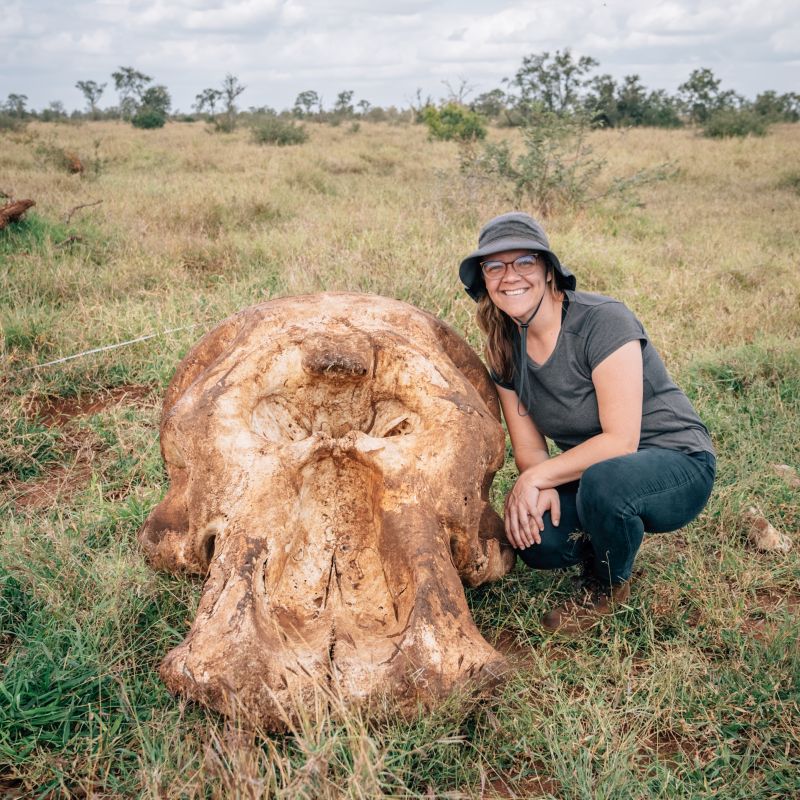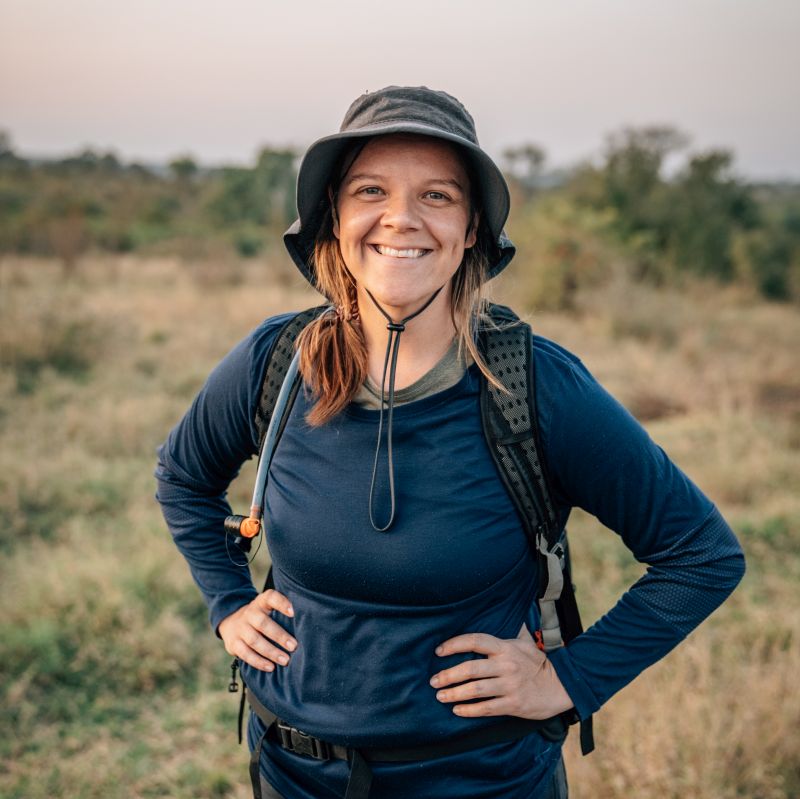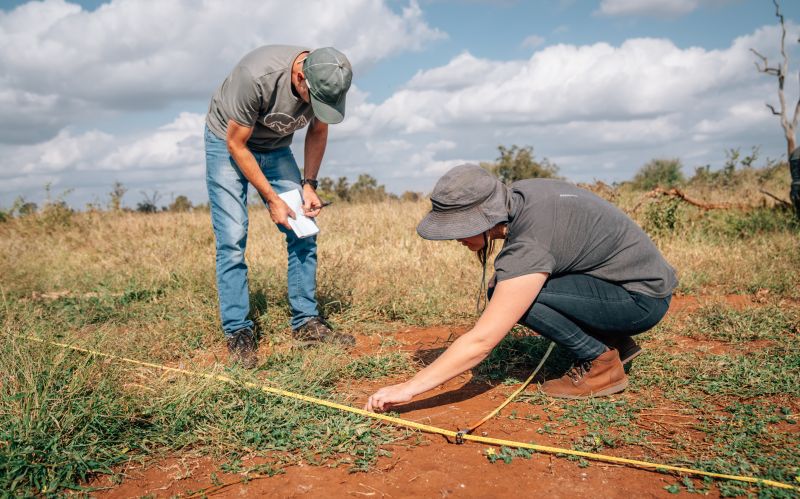eNews
#04 2024
Meet EFTEON’s new landscape scientist for biodiversity and ecology
Dr Helga Knoetze joined the Expanded Freshwater and Terrestrial Environmental Observation Network* (EFTEON) in February this year. As landscape scientist for biodiversity and ecology, Helga is responsible for developing the EFTEON Biodiversity Observation Research Programme for long-term observations of key biological communities across terrestrial and aquatic floral, faunal and (potentially) microbial diversity. Her portfolio includes the development of site technicians and scientists.
“Being part of a multidisciplinary team contributing to a better understanding of earth system dynamics through studying biodiversity in one of the most species-rich countries in the world, is both exciting and a privilege,” she explains.
SAEON eNews spoke to Helga to learn more about her interest in the ecology of herbaceous communities in nutrient hotspots of semi-arid African savannas, the fascinating research projects she’s been involved in, her off-road driving skills and the exciting and unusual challenges she will be facing in her new position.
Recent field work in the Kruger National Park involved tracking down variously aged carcasses of dead elephants (Photo: Velly Ndlovu, SANParks Scientific Services)
Dr Helga Knoetze has a PhD in Environmental Sciences from North-West University.
Q Helga, please give our readers a concise overview of what your position at EFTEON entails, and where and how it fits into the overall structure of EFTEON?
I am a landscape scientist for EFTEON, and although I am based at the Arid Lands Node in Kimberley, I am responsible for biodiversity observations across the six EFTEON landscapes.
EFTEON’s mission as a Research Infrastructure (RI) is to offer public value through the provisioning of long-term, multidisciplinary observation platforms that are designed to clarify earth system dynamics, changes over multiple scales, and to distinguish between natural and anthropogenic environmental change. At EFTEON we aim to support and promote long-term environmental observations, research and data collection across the landscapes following a transdisciplinary approach, distributing landscape-scale research infrastructure, facilitating research at different scales within and between landscapes, linking science themes such as ecohydrology, carbon/nutrient cycling, soils and sediments, biodiversity, climate and the atmosphere, and social-ecological systems.
As biodiversity scientist, my focus is on this science theme, and my role is to develop the strategy for long-term biodiversity observations and research of key functional types (plants, mammals, small vertebrates, terrestrial invertebrates, aquatic vertebrates, soil microbes and sediments), so that we can use biodiversity patterns to answer questions pertaining to climate change, land use change and earth system dynamics across the landscapes.
Q What attracted you to this key position at EFTEON?
“Biological diversity (or biodiversity) is the key to the maintenance of the world as we know it.”
Edward O. Wilson
Biodiversity underpins life as we know it, and forms the building blocks for ecosystem functioning and services. Conserving global biodiversity is therefore vital, however, you cannot protect something that you don’t understand. It is therefore important for us to study and understand patterns of biodiversity, and how they change in response to environmental or anthropogenic drivers across various landscapes.
Despite appreciating the importance of studying biodiversity, I’ve always found it to be interesting, dynamic and fun. Additionally, to be part of a multidisciplinary team contributing to a better understanding of earth system dynamics through studying biodiversity in one of the most species-rich countries in the world, is exciting and a privilege.
Q Did you have any prior experience of SAEON and its long-term research projects?
Before I was appointed to the landscape scientist position, I was a Professional Development Programme (PDP) postdoctoral fellow at SAEON’s Ndlovu Node in the Lowveld. Here, we are looking at the long-term impacts of the megacarcasses of elephants on the surrounding environment (vegetation, soil nutrients, mammals, microbes). Moreover, I assisted with long-term monitoring of vegetation in the Letaba exclosures in 2012.
Q Will you be working closely with all the SAEON nodes?
Yes, definitely. Especially being based at the Arid Lands Node, there are many opportunities to work closely with colleagues here. We have already collaborated on many occasions, for example on the SAEON Graduate Student Network (GSN) science engagement events, field work campaigns and calibrations of equipment within the landscape.
I am also privileged to still be a part of the megacarcass project currently running at the Ndlovu Node. Also, EFTEON has infrastructure established in many of the SAEON nodes, for example the Fynbos and Grasslands nodes, so I am looking forward to visiting these sites more often and hope to collaborate with colleagues there.
Q Who are the external stakeholders you will be involving, and how do you intend securing their buy-in?
External stakeholders that I would like to involve, and some that I am already starting to collaborate with, include South African National Parks (SANParks) – since Mokala National Park will be one of the landscape’s secondary sites, Sol Plaatje University, the De Beers Group – as our flux towers are established on one of their nature reserves, and perhaps also the University of the Free State and Sol Plaatje Municipality. I also intend to include stakeholders from the community, such as non-governmental organisations (NGOs).
Most of these stakeholders are eager to collaborate with EFTEON as we can provide them with the necessary research infrastructure to enable them to collect long-term observational data for their own research projects. Buy-in from NGOs and the local municipality will most probably be secured through the provisioning of information needed to create a better and more sustainable society for the people in the landscape.
Q Will your work be aligned with South Africa’s National Biodiversity Strategy and Action Plan (NBSAP)?
I think it is good practice to aim to meet national, if not international standards in your work. Although the EFTEON Biodiversity Strategy will incorporate aspects from the NBSAP, there is also a Biodiversity Technical Thematic Committee composed of a panel of experts in various biodiversity themes (such as vegetation ecology, freshwater ecology, invertebrate biology and microbial ecology and genomics), that act in an advisory capacity in the development of the strategy.
The strategy will furthermore be streamlined to suit the various EFTEON landscapes, and the questions that stakeholders and researchers want answered within and across the landscapes.
Q The EFTEON Biodiversity Observation Research Programme is to be implemented across all six EFTEON landscapes and in conjunction with appropriate internal and external stakeholders. The programme will include procedures and requirements for repeated vegetation surveys; assessment of assemblages of small vertebrates, terrestrial invertebrates and freshwater aquatic species; and observations of bio-indicators in relation to water quality. This seems an exceptionally extensive field to cover; how do you deal with the magnitude of it all?
It can seem quite overwhelming at times, but there are a few important things to remember. First of all, I am part of a team, not only the internal team within EFTEON, but also the external Biodiversity Technical Thematic Committee members, collaborators and stakeholders. It is impossible to be an expert in everything, and one would need to seek advice and assistance from time to time.
Another important thing to remember is that one does not have to reinvent the wheel. There are many excellent biodiversity strategies available that can be used to inform the EFTEON strategy. And then, Rome was not built in a day. It is important to take the time required to develop a programme such as this, which can be challenging in a world where everything happens relatively “fast” (think fast food, instant coffee and Google).
Q It must be a definite aim of the programme that your research results and data are available and accessible to local and international scientists. How do you intend to accomplish that?
EFTEON’s goals include the development of open-access data systems and tools, and the supply and sharing of reliable, high-quality long-term observational data. For EFTEON to reach these goals, SAEON’s uLwazi (meaning ‘knowledge’) Node will play a vital role. uLwazi organises and maintains data and develops open data systems and applications which are distributed on an Open Data Platform (ODP). The challenge will be for the biodiversity data to be in a standardised format before it can be shared on the ODP. For this, I will explore national and international biodiversity databases to see what is important to include, and in what format data need to be captured.
Q Will your research results feed into the national spatial biodiversity assessment?
As a research infrastructure, EFTEON aims to provide a platform for long-term biodiversity observations. It is therefore our goal to collaborate with, and provide reliable long-term observational data to researchers, scientists, students and stakeholders. Research sprouting from the data can feed into the national spatial biodiversity assessment, however, the research will not be ours per se.
Q You will be working across all six EFTEON landscapes but where are you based, and why?
I will be responsible for biodiversity observation research across the six EFTEON landscapes, while being based in Kimberley, Northern Cape. The landscape did not have a scientist until I arrived, so it is my responsibility to help develop and manage the landscape –managing the EFTEON landscape office, vehicle and instrumentation, and identifying where the satellite sites are to be situated.
Q You are responsible for facilitating the day-to-day operations of the EFTEON landscape and biodiversity data in your charge in line with SAEON best practice. This includes managing a team of technicians responsible for instrumentation, biodiversity sampling and social ecological sampling and surveys operations. Do you have any previous experience in these levels of management?
As a student supervisor, I have experience in managing students at a postgraduate level. This position exposed me to various responsibilities that promoted the development of skill sets which I can now apply in managing my team here in Kimberley. For example, efficient management of time, finances, administration, as well as logistical planning and implementation. In managing people, it is important to remember that people are not all the same, they remain unique individuals with different strengths and weaknesses.
Q Instrumentation will obviously play a crucial role in the EFTEON Biodiversity Observation Research Programme. In the ever-evolving natural ecosystems in which you are active, how do you ensure that the instruments and operational equipment you and members of your team use are the latest and best possible versions available globally? And how do you maintain these highly sensitive and sophisticated instruments and equipment?
It is vital to stay abreast of the latest developments in instrumentation and technology, in your own field (biodiversity) as well as in others. This is to ensure high-quality programmes which adhere to national and even international standards. Sufficient and regular maintenance of the existing equipment and instruments is very important. Instruments and equipment need to be stored safely and adequately, and handled with care.
Q You have a PhD in Environmental Sciences from North-West University, for which you investigated the community ecology of herbaceous vegetation in a semi-arid sodic savanna. Did this pave the way for your interest in researching semi-arid environments?
Most definitely. These environments inspire me – they are resilient and dynamic. Even though conditions are not always ideal, even harsh at times, they wait patiently for conditions to improve, while still being able to function and provide. They flower where they are planted, so to speak, making the best of everything nature throws at them.
Q You’ve been involved in a wide range of projects – from investigating drought-tolerant forb flora of a semi-arid protected savanna to looking at the effects of megacarcasses on plant productivity and forage quality across megacarcass sites of different ages. How did these contribute to your overall skills set for this position?
Having the privilege to study the environment and how it works and responds to environmental changes has been such a blessed journey. It seems as if my whole postgraduate career has been training and preparing me for this position. Having done a PhD and a couple of postdocs taught me a lot about myself and my abilities.
During these studies, I developed a range of skills that I can apply in my current position. People generally are reluctant to talk about their weaknesses, but during my studies I also came to realise what I am not so good at. It is important to see these not as weaknesses, but as opportunities for growth. I am thankful for each opportunity that helped form who I am, and my abilities today.
Q Mega-carcasses are unusual hotspots of biological activity in a landscape, what are the key results from this study? How does the death of a large animal impact the immediate environment and how far are those impacts felt?
This is an ongoing, long-term study, trying to tease out what the effects of the megacarcasses of elephants are on the surrounding environment. It is a multidisciplinary study involving botanists, soil scientists, entomologists and large herbivore specialists. In terms of vegetation dynamics, it is already evident that the plant species growing at carcass sites are different from species occurring in the surrounding matrix, both in terms of structure and function. Elephant carcasses are therefore considered unique disturbance types, adding to the spatial complexity of semi-arid savannas. Data analyses are still ongoing, and we anticipate many more interesting findings to report.
The death of these megaherbivores, and the corresponding inputs of nutrients into the soil, have strong impacts on the surrounding environment. From field observations we could see a clear zone of impact up to 3.5 m away from the carcass, with the impact zone seemingly being less visible 10 m and further away from the carcass. These observations were corroborated by preliminary soil nutrient data, indicating higher levels of nutrients 0–3.5 m away from the carcass, compared to 10 m and further away, where nutrient levels were lower.
Helga has considerable experience working in the savannas of the South African lowveld, particularly the Kruger National Park and adjacent rangelands.
Music is a big part of Helga’s life, and she enjoys playing the acoustic guitar and singing along.
Q Your responsibilities will take you to remote locations, where you may have to work in strenuous outdoor environments. How would you rate your off-road driving skills?
I am a certified off-road driver and I know what to do under different conditions. However, I must admit I feel more comfortable being the passenger.
Q You’ve been the recipient of several awards, grants and bursaries. Which one meant the most to you, and why?
I recently received the award for the best poster presentation at the Annual Congress of the Grasslands Society of Southern Africa (link to article). I would have to say this is my favourite one so far, partly because I did not expect it, and partly because I was representing EFTEON, and the work we do. I felt a sense of accomplishment, and a feeling of pride and reassurance that I am at the right place.
Q As a published author, you have a particular interest in writing and publishing. You’ve also attended North-West University’s science writing workshops. How will these skills be of benefit in your new position?
Being trained as a scientist and researcher, my ambition is to continue working on, and expanding my publishing record and h-index. Additionally, the scientific writing style will be useful when writing grant applications, and when supervising or promoting postgraduate students.
Another benefit of this skill is being able to serve as an associate editor or reviewer to peer-reviewed scientific journals. I was recently appointed as an associate editor for the African Journal of Range & Forage Science, so this skill will come in handy for this exciting task.
Q Does all that leave any time for hobbies?
Living a balanced life is so important, and I always make time to wind down and do something that’s fun! Being a botanist, I enjoy spending time outside with my husband, be that doing some gardening, going for a hike, or riding a bicycle through a nature reserve. Being healthy is also important, so I do like going for a jog.
In the house, I like to bake and cook. I try my best to find some time to draw a pencil sketch or a picture with oil pastels or acrylic paint. Music is a big part of my life, and I like to play the acoustic guitar and sing along.
Q Do you have a personal philosophy that you live by?
“People who mind, don’t matter, and people who matter, don’t mind”. Just stay true to who you are, and be yourself, and you will attract the right people!
* The Expanded Freshwater and Terrestrial Environmental Observation Network (EFTEON) is a research infrastructure that has been developed under the South African Research Infrastructure Roadmap (SARIR) programme. EFTEON is intended to provide a platform of well-described and well-instrumented landscapes to the South African and international research community, to facilitate research into global change, ecosystem processes and social-ecological interactions. It provides data for remote sensing as well as model validation and calibration.






